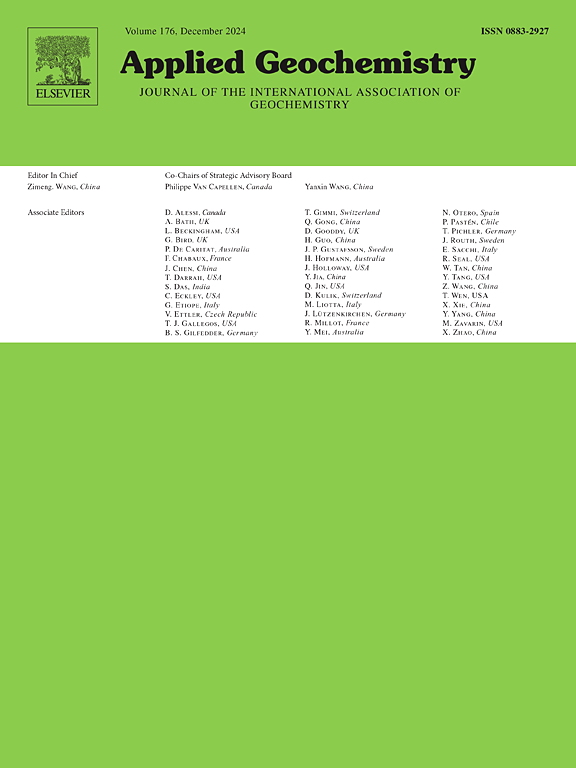Two-phase reactive transport modeling of heterogeneous gas production in a low- and intermediate-level radioactive waste repository
IF 3.1
3区 地球科学
Q1 GEOCHEMISTRY & GEOPHYSICS
引用次数: 0
Abstract
Deep geological disposal is a widely proposed approach for safe storage of low- and intermediate-level radioactive waste (L/ILW) for tens to hundreds of thousands of years. Although the use of cement materials will maintain a high pH environment that is favorable for radionuclide retention, slows down metal corrosion, and suppresses microbial activity, different gases may still be produced by chemical reactions, such as pH-dependent anoxic corrosion of metals, and the degradation of organic matter as well. Both reactions consume water and may lead to the formation of a free gas phase within and around the repository.
In order to investigate the controlling factors of this gas production processes, a coupled reactive transport model of component-based two-phase flow in the OpenGeoSys framework is adopted here. Building on the previous work by Huang et al. (2021), this work extends the geometric configuration of the model from a single drum to the scale of a waste container (12 drums) in order to more realistically model the water and gas fluxes. The geochemical evolution of a container filled with cemented steel drums and surrounded by mortar and host rock is simulated in a two-dimensional setup over 500 years. The relative humidity in the pore space as measure of water availability determines the chemical reactivity.
We have conducted a sensitivity study for the influence of mortar capillarity and permeability on gas production over time in the waste drums. As expected, the amount of gas produced within the first several years depends primarily on the initial water content within the waste drum and the amount of fast degradable waste stored in a drum. Later, this feedback system is forced into a new equilibrium, where the water transport has to match the water consumption rate at the waste package. Both, the mortar capillarity and permeability control the point in time when the equilibrium is reached and the subsequent rate of gas production.
This study shows how reactive transport models are capable to help with the understanding of couplings between chemical and transport processes that control gas generation in L/ILW waste repositories, especially in barrier systems with different material properties. Future studies could benefit from more accurate parameterization of the chemical reactions, depending on the availability of new experimental data and/or more realistic process-based model approaches.
低、中水平放射性废物储存库非均质产气的两相反应输运模型
深层地质处置是一种被广泛提出的安全储存中低水平放射性废物(L/ILW)数万至数十万年的方法。尽管水泥材料的使用将维持一个有利于放射性核素保留的高pH环境,减缓金属腐蚀,抑制微生物活动,但化学反应仍然可能产生不同的气体,例如金属的pH依赖性缺氧腐蚀,以及有机物的降解。这两种反应都消耗水,并可能导致储存库内部和周围形成自由气相。为了研究该产气过程的控制因素,本文采用OpenGeoSys框架下基于组分的两相流耦合反应输运模型。在Huang等人(2021)之前工作的基础上,本工作将模型的几何配置从单个桶扩展到废物容器(12个桶)的规模,以便更真实地模拟水和气体通量。在二维环境中,模拟了一个充满胶结钢桶并被砂浆和宿主岩石包围的容器500多年来的地球化学演化过程。孔隙空间的相对湿度作为水分有效性的度量决定了化学反应性。我们进行了一项敏感性研究,研究砂浆毛细性和渗透率对废鼓中随时间推移的产气量的影响。正如预期的那样,最初几年产生的气体量主要取决于废物桶内的初始含水量和储存在桶中可快速降解的废物的数量。后来,这个反馈系统被迫进入一个新的平衡,在这个平衡中,水的运输必须与废物包装的水消耗率相匹配。砂浆的毛细和渗透率都控制着达到平衡的时间点和随后的产气速度。这项研究显示了反应输运模型如何能够帮助理解控制L/ILW废物储存库中气体生成的化学和输运过程之间的耦合,特别是在具有不同材料特性的屏障系统中。未来的研究可能受益于更准确的化学反应参数化,这取决于新的实验数据的可用性和/或更现实的基于过程的模型方法。
本文章由计算机程序翻译,如有差异,请以英文原文为准。
求助全文
约1分钟内获得全文
求助全文
来源期刊

Applied Geochemistry
地学-地球化学与地球物理
CiteScore
6.10
自引率
8.80%
发文量
272
审稿时长
65 days
期刊介绍:
Applied Geochemistry is an international journal devoted to publication of original research papers, rapid research communications and selected review papers in geochemistry and urban geochemistry which have some practical application to an aspect of human endeavour, such as the preservation of the environment, health, waste disposal and the search for resources. Papers on applications of inorganic, organic and isotope geochemistry and geochemical processes are therefore welcome provided they meet the main criterion. Spatial and temporal monitoring case studies are only of interest to our international readership if they present new ideas of broad application.
Topics covered include: (1) Environmental geochemistry (including natural and anthropogenic aspects, and protection and remediation strategies); (2) Hydrogeochemistry (surface and groundwater); (3) Medical (urban) geochemistry; (4) The search for energy resources (in particular unconventional oil and gas or emerging metal resources); (5) Energy exploitation (in particular geothermal energy and CCS); (6) Upgrading of energy and mineral resources where there is a direct geochemical application; and (7) Waste disposal, including nuclear waste disposal.
 求助内容:
求助内容: 应助结果提醒方式:
应助结果提醒方式:


